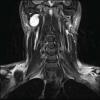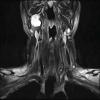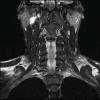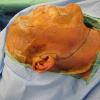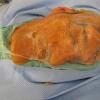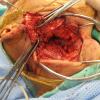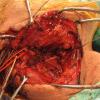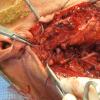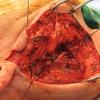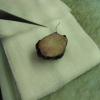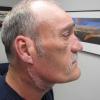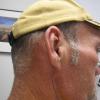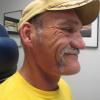click on image above to enlarge; advance with cursor over border
see also: Parotidectomy with Facial Nerve Dissection; First Bite Syndrome
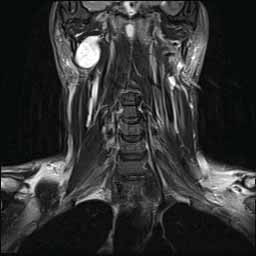 |
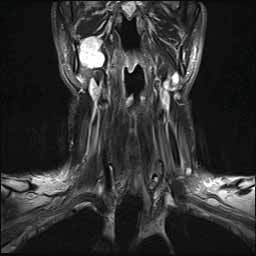 |
 |
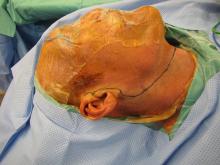 |
|
May 23 2011 - resection pleomorphic adenoma of parapharyngeal space (deep lobe parotid) |
|||
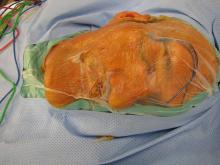 |
 |
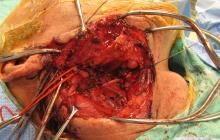 |
 |
 |
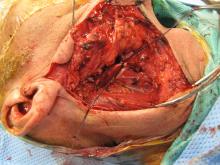 |
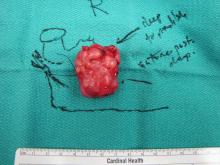 |
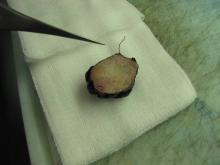 |
|
Sutures distracted segments of digastric and stylohyoid muscles that were severed at their midportion to improve access to the parapharyngeal space |
|||
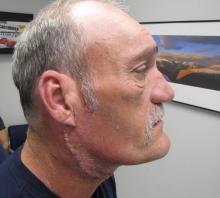 |
 |
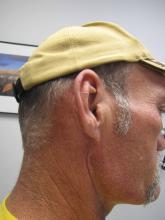 |
 |
|
Post operative day #8 |
POD #8 with facial nerve function intact |
POD #108 |
POD #108 |
DESCRIPTION OF OPERATION
Informed written consent was obtained and reviewed with the patient, and the patient was then transferred to the OR, placed in the supine position, induced and intubated by Anesthesia with the ET tube taped on the left corner of the mouth. All pressure points were attended to with the arms tucked at the sides. The bed was turned 180 degress (head away from anesthesia) employing extensions to ventilation circuits. The head of the bed was elevated and the neck extended. Needle electrodes (NIMS = nerve integrity monitoring system) were placed into the orbicularis oculi (red) and orbicularis oris (blue). A planned doubly modified Blair incision line was injected, using 1:100,000 of epinephrine and a total of 6 mL, including the parotid skin flap and the incision line.
The patient was prepped (betadine solo prep) and draped in a sterile fashion including an oral prep (throat pack placed, dilute betadine solutions placed in mouth and removed with suction with the throat pack then removed.) Draping with sterile towels was done to permit view of the ipsilateral hemi-face and neck and then covered with a large incise drape. The incise drape was then trimmed.
The incision was made from the inferior edge of the tragus, just anterior to the ear preauricularly, around into the neck for transcervical approach, approximately 2 cm inferior to the mandible extending to just short of midline. The marginal mandibular nerve was identified using the Parsons-McCabe nerve stimulator and raised superiorly after tracing the nerve (in a retrograde fashion) to the pes anserinus. The shaw scalpel was used to remove the superficial parotid gland overlying the nerve as it was traced back posteriorly.
The great auricular nerve was identified with the posterior branches to the earlobe preserved. The SCM was de-invested of fascia along its anterior length with identification of the digastric muscle along with the posterior-inferior aspect of the submandibular gland. The submandibular gland was mobilized anteriorly to provide access to the parapharyngeal space. At that point in time, the base of the tumor was palpated as a discrete mass posteriorly superior to the posterior belly of the digastric muscle and anterior to the sternocleidomastoid muscle. The stylohyoid muscle was also overlying the mass. Improve access to the parapharyngeal space, the tendon for the posterior belly of digastric as was the stylohyoid muscle with sutures placed for later reapproximation of the muscles.
The external carotid artery was identified overlying the tumor and was ligated with stick-ties and dividied. With this improved access to the parapharyngeal space, the tumor was identified as circumscribed and readily separated from adjacent soft tissue for removal.
Hemostasis was confirmed. The digastric muscle and the stylohyoid muscle were reapproximated, using 3-0 Vicryl sutures in a horizontal mattress fashion. The facial nerve was stimulated at 1 mV at the end of the case at the pes anserinus and was noted to be fully functional.
Two fully perforated, 10-mm JP drains were placed posteriorly, one up into the parapharyngeal space, the other to drain the neck inferiorly. The skin flap was then closed with a deep suture, using 3-0 Vicryl in an interrupted fashion, in addition to 5-0 nylon used in a running locking fashion to close the superficial tissue. The patient was then returned to Anesthesia in good condition.
References
Olsen KD: Tumors and surgery of the parapharyngeal space. Laryngoscope 1994 May;104(5 Pt2 Suppl 63):1-28
Presutti L, Molteni G, Malve L, Marchioni D, Ghidini A, Tassi S, Chiarini L, Alicandri-Ciufelli M: Parapharyngeal space tumors without mandibulotomy: our experience. Eur ARch Otorhinolaryngol 2011 Arp 3. (Epub)
